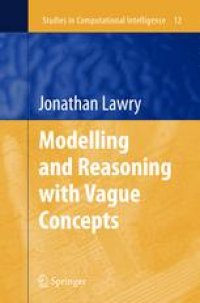
Ebook: Modelling and Reasoning with Vague Concepts
Author: Dr. Jonathan Lawry (auth.)
- Tags: Artificial Intelligence (incl. Robotics), Systems and Information Theory in Engineering, Pattern Recognition, Information and Communication Circuits, Probability and Statistics in Computer Science, Mathematical Logic and Formal Language
- Series: Studies in Computational Intelligence 12
- Year: 2006
- Publisher: Springer US
- Edition: 1
- Language: English
- pdf
Vagueness is central to the flexibility and robustness of natural language descriptions. Vague concepts are robust to the imprecision of our perceptions, while still allowing us to convey useful, and sometimes vital, information. The study of vagueness in Artificial Intelligence (AI) is therefore motivated by the desire to incorporate this robustness and flexibility into intelligent computer systems. Such a goal, however, requires a formal model of vague concepts that will allow us to quantify and manipulate the uncertainty resulting from their use as a means of passing information between autonomous agents.
This volume outlines a formal representation framework for modelling and reasoning with vague concepts in Artificial Intelligence. The new calculus has many applications, especially in automated reasoning, learning, data analysis and information fusion. This book gives a rigorous introduction to label semantics theory, illustrated with many examples, and suggests clear operational interpretations of the proposed measures. It also provides a detailed description of how the theory can be applied in data analysis and information fusion based on a range of benchmark problems.
Vagueness is central to the flexibility and robustness of natural language descriptions. Vague concepts are robust to the imprecision of our perceptions, while still allowing us to convey useful, and sometimes vital, information. The study of vagueness in Artificial Intelligence (AI) is therefore motivated by the desire to incorporate this robustness and flexibility into intelligent computer systems. Such a goal, however, requires a formal model of vague concepts that will allow us to quantify and manipulate the uncertainty resulting from their use as a means of passing information between autonomous agents.
This volume outlines a formal representation framework for modelling and reasoning with vague concepts in Artificial Intelligence. The new calculus has many applications, especially in automated reasoning, learning, data analysis and information fusion. This book gives a rigorous introduction to label semantics theory, illustrated with many examples, and suggests clear operational interpretations of the proposed measures. It also provides a detailed description of how the theory can be applied in data analysis and information fusion based on a range of benchmark problems.
Vagueness is central to the flexibility and robustness of natural language descriptions. Vague concepts are robust to the imprecision of our perceptions, while still allowing us to convey useful, and sometimes vital, information. The study of vagueness in Artificial Intelligence (AI) is therefore motivated by the desire to incorporate this robustness and flexibility into intelligent computer systems. Such a goal, however, requires a formal model of vague concepts that will allow us to quantify and manipulate the uncertainty resulting from their use as a means of passing information between autonomous agents.
This volume outlines a formal representation framework for modelling and reasoning with vague concepts in Artificial Intelligence. The new calculus has many applications, especially in automated reasoning, learning, data analysis and information fusion. This book gives a rigorous introduction to label semantics theory, illustrated with many examples, and suggests clear operational interpretations of the proposed measures. It also provides a detailed description of how the theory can be applied in data analysis and information fusion based on a range of benchmark problems.
Content:
Front Matter....Pages i-xxv
Introduction....Pages 1-7
Vague Concepts and Fuzzy Sets....Pages 9-39
Label Semantics....Pages 41-83
Multi-Dimensional and Multi-Instance Label Semantics....Pages 85-102
Information from Vague Concepts....Pages 103-137
Learning Linguistic Models from Data....Pages 139-187
Fusing Knowledge and Data....Pages 189-219
Non-Additive Appropriateness Measures....Pages 221-233
Back Matter....Pages 235-246
Vagueness is central to the flexibility and robustness of natural language descriptions. Vague concepts are robust to the imprecision of our perceptions, while still allowing us to convey useful, and sometimes vital, information. The study of vagueness in Artificial Intelligence (AI) is therefore motivated by the desire to incorporate this robustness and flexibility into intelligent computer systems. Such a goal, however, requires a formal model of vague concepts that will allow us to quantify and manipulate the uncertainty resulting from their use as a means of passing information between autonomous agents.
This volume outlines a formal representation framework for modelling and reasoning with vague concepts in Artificial Intelligence. The new calculus has many applications, especially in automated reasoning, learning, data analysis and information fusion. This book gives a rigorous introduction to label semantics theory, illustrated with many examples, and suggests clear operational interpretations of the proposed measures. It also provides a detailed description of how the theory can be applied in data analysis and information fusion based on a range of benchmark problems.
Content:
Front Matter....Pages i-xxv
Introduction....Pages 1-7
Vague Concepts and Fuzzy Sets....Pages 9-39
Label Semantics....Pages 41-83
Multi-Dimensional and Multi-Instance Label Semantics....Pages 85-102
Information from Vague Concepts....Pages 103-137
Learning Linguistic Models from Data....Pages 139-187
Fusing Knowledge and Data....Pages 189-219
Non-Additive Appropriateness Measures....Pages 221-233
Back Matter....Pages 235-246
....